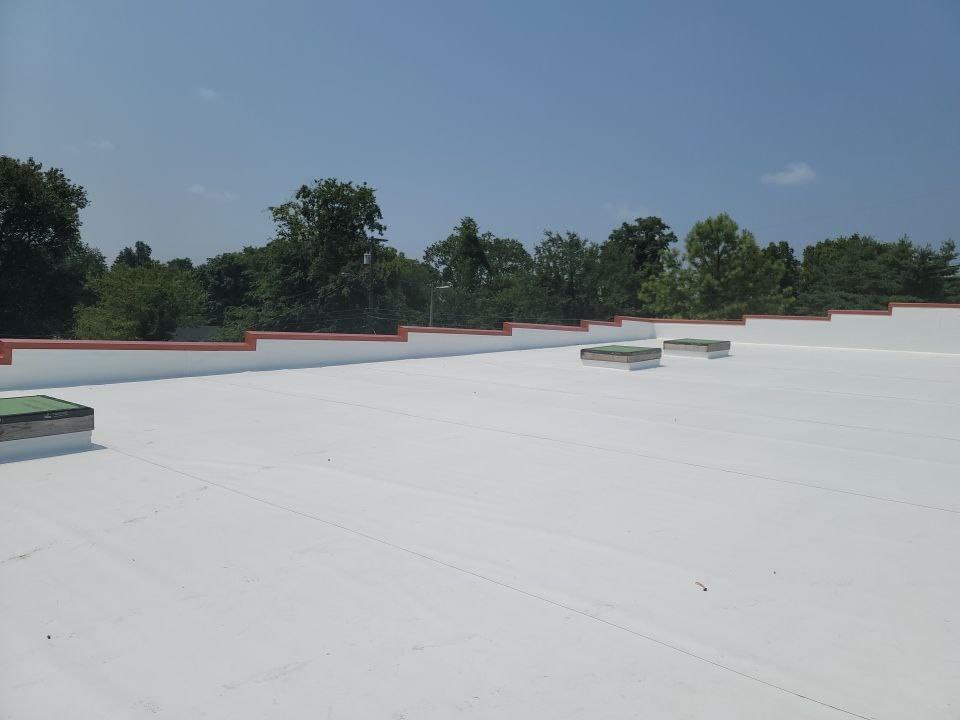About Us
Advanced Roofing Technologies, your dependable partner for durable, efficient, and affordable flat roofing solutions. Protecting your home, one roof at a time.
Instant Quote Instant QuoteContact Info
- 950 W Venango Street
Philadelphia PA 19140 - 267-277-2124
- [email protected]
- Week Days: 09.00 to 18.00
Sunday: Closed
TPO Roofing
- Services
- TPO Roofing

TPO, short for Thermoplastic Olefin, is a single-ply roofing membrane widely used in the construction industry. It is composed of a blend of polymer materials, typically ethylene-propylene rubber and polypropylene. TPO roofing membranes are known for their durability, energy efficiency, and ease of installation.
TPO membranes are typically white or light-colored, which helps reflect sunlight and reduce heat absorption, resulting in improved energy efficiency and lower cooling costs. They are available in varying thicknesses to accommodate different project requirements.
One of the notable features of TPO roofing membranes is their seam strength. The seams of TPO membranes are typically heat-welded together, creating a strong, watertight bond that ensures superior protection against leaks and water infiltration.
TPO membranes are lightweight, flexible, and easy to work with, making them popular among roofing professionals for both new construction and retrofit projects. They can be mechanically attached, fully adhered, or ballasted during installation, offering flexibility in application methods.
Pros and Cons of TPO Roofing
It's important to consider your specific project requirements, budget, and environmental factors when evaluating the pros and cons of TPO roofing. Consulting with Advanced Roofing Technologies can provide further insights and help determine if TPO is the right choice for your roofing needs.
| Pros | Cons |
|---|---|
| Energy Efficiency: TPO roofing membranes have excellent reflective properties, helping to reduce heat absorption and lower cooling costs. The light-colored surface reflects sunlight, making it an energy-efficient choice for buildings in hot climates. | Limited Longevity Data: While TPO roofs have been on the market for several decades, long-term data on their longevity is still limited compared to other roofing materials. The lifespan of TPO roofs can vary depending on factors such as installation quality, maintenance practices, and environmental conditions. |
| Durability: TPO roofing is highly durable and can withstand various weather conditions, including UV radiation, ozone, and chemical exposure. It has good resistance to tears, punctures, and impacts, contributing to its long-lasting performance. | Susceptible to Chemical Damage: TPO roofs can be sensitive to certain chemicals, including some cleaning agents and roofing adhesives. Care should be taken to avoid contact with incompatible substances to prevent potential damage to the membrane. |
| Cost-Effective: TPO roofing is often considered a cost-effective option due to its reasonable material cost and relatively simple installation process. It offers a good balance between affordability and performance, making it a popular choice for commercial and residential applications. | Scuffing and Fading Concerns: TPO roofing membranes are susceptible to scuffing, which can occur during installation or due to foot traffic. Additionally, some TPO roofs may experience fading or discoloration over time, especially in areas with high UV exposure. |
Lifespan of TPO Roofing
The lifespan of TPO (Thermoplastic Olefin) roofing can vary depending on several factors, including the quality of installation, environmental conditions, and regular maintenance. Severe weather events, improper installation, or lack of maintenance can also impact the overall lifespan of the roof. However, TPO roofing systems are generally designed to have a lifespan of 15 to 20 years or more.
TPO roofing membranes have gained popularity in the roofing industry due to their affordability, energy efficiency, and reliable performance. When installed and maintained correctly, TPO membranes can provide a durable, watertight roofing solution for commercial, industrial, and residential buildings.
Regular maintenance and inspections are also essential to maximize the lifespan of TPO roofing systems. This includes keeping the roof clean, checking for any signs of damage or wear, and addressing any issues promptly.
What Is Better Than TPO Roofing?
The Lotus High-Performance Product Line stands out as a superior roofing solution when compared to TPO (Thermoplastic Polyolefin) roofing for several reasons.
One of the key advantages is the use of pure elastomeric hydrophobic polyurethane resins in products like Lotus B2 Base Coat, providing exceptional mechanical, chemical, thermal, UV, and natural element resistance. Unlike TPO roofing, which can be vulnerable to heat and UV damage over time, the Lotus High-Performance Product Line offers superior weather resistance and UV protection, ensuring the longevity and durability of the roofing system.
Another crucial distinction is the crack-bridging capability of the Lotus High-Performance Product Line, specifically Lotus B2 Base Coat, which can withstand cracks up to 2 mm even in cold temperatures as low as -10˚C. TPO roofing may struggle to maintain its integrity in extreme weather conditions, potentially leading to leaks and compromises in the roofing system's performance. The seamless membrane formation of Lotus B2 Base Coat without joints also eliminates weak points, further enhancing its leak resistance compared to TPO roofing, which may have seams susceptible to wear and tear.
Additionally, the Lotus High-Performance Product Line offers excellent adhesion to various surfaces, including concrete, metal, and wood, making it a versatile choice for different roofing applications. TPO roofing, on the other hand, may have limitations in terms of adhesion to certain materials, potentially limiting its applicability in diverse roofing projects.

